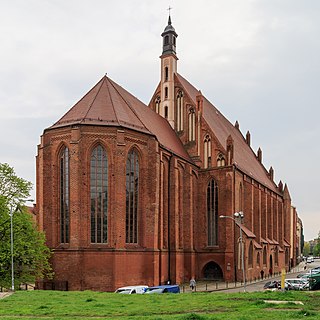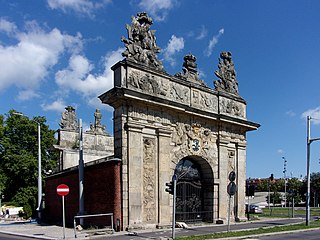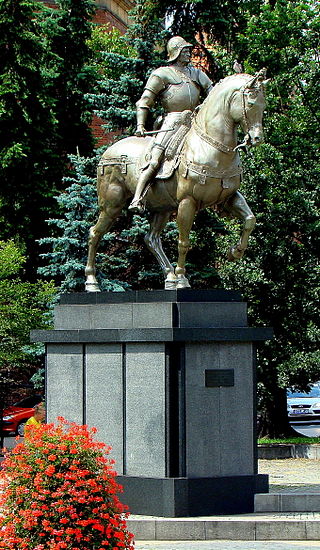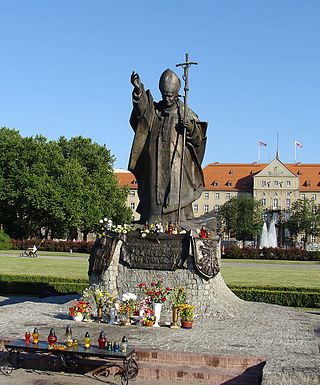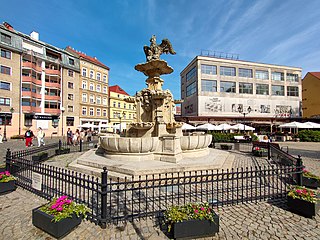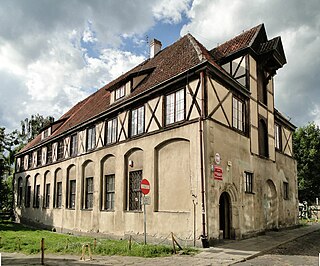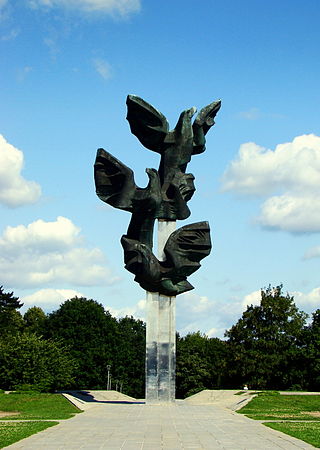40 Sights in Szczecin, Poland (with Map and Images)
Legend
Welcome to your journey through the most beautiful sights in Szczecin, Poland! Whether you want to discover the city's historical treasures or experience its modern highlights, you'll find everything your heart desires here. Be inspired by our selection and plan your unforgettable adventure in Szczecin. Dive into the diversity of this fascinating city and discover everything it has to offer.
Sightseeing Tours in SzczecinActivities in Szczecin1. Prawosławna Parafia św. Mikołaja
The Orthodox Church of St. Nicholas is an Orthodox co-cathedral and parish church in Szczecin. It belongs to the Szczecin deanery of the Wrocław-Szczecin diocese of the Polish Autocephalous Orthodox Church.
2. Kościół świętego Jana Ewangelisty
Church of St. John the Evangelist in Szczecin – a Gothic, non-oriented post-Franciscan church at 9 St. Ducha Street in Szczecin. It is the only surviving building of the former Gothic, Franciscan monastery complex. The church is located on the European Route of Brick Gothic.
Wikipedia: Kościół św. Jana Ewangelisty w Szczecinie (PL), Url, Url 0
3. Kościół świętego Piotra i świętego Pawła
The Church of St. Peter and St. Paul in Szczecin – a small Gothic brick aisleless church in Szczecin. This church is located on the European Route of Brick Gothic. Currently, it is a parish church of the Polish Catholic Church.
4. Baszta Panieńska
The Maiden Tower also known as the Seven Coats Tower – the building is located near the Oder River at the foot of the Pomeranian Dukes' Castle at 47 Panieńska Street in Szczecin. It was entered into the register of monuments under No. 8 of 11 June 1954.
5. Fontanna Manzla
The Manzel Fountain – a building consisting of a fountain pool by Otto Rieth and a figural composition by Ludwig Manzel, once located at Tobrucki Square, at the intersection of today's Dworcowa and Nowa Streets in Szczecin. In the place of the non-preserved composition, the Monument with an Anchor was erected. The monument was an inspiration for the Sedina fountain built after the war according to the design of Mieczysław Glib and placed on Bolesław Chrobry Square in Police.
6. Brama Portowa
The Port Gate, hist. German: Berliner Tor – one of the city gates of Szczecin, built in the Baroque style in the years 1725–1727 according to the design of the Dutch fortification designer Gerhard Cornelius van Wallrawe.
7. Archikatedra pw. Świętego Jakuba Apostoła
The St. James the Apostle Archcathedral Basilica is a Gothic cathedral located in Szczecin, Poland and seat of the Archdiocese of Szczecin-Kamień. Built in the 12th-14th centuries, it is the second tallest church in Poland, the largest church in the region of Western Pomerania, and one of the most distinctive landmarks of the Szczecin Old Town.
8. Wieża Quistorpa
Quistorp's Tower – an observation tower on the Arkona Hill in the Arkoński Forest in Szczecin (Osów), erected in the years 1900–1904; since the end of World War II in a state of ruin; entered into the register of immovable monuments of the West Pomeranian Voivodeship.
9. Royal Gate
The Royal Gate – one of the city gates of Szczecin, located on the Prussian Homage Square. It was built in the years 1725–1728 on the occasion of the occupation of the city by Prussia according to the design of the Dutch fortification designer Gerhard Cornelius van Wallrawe.
10. Kościół pw. Świętego Jana Chrzciciela
The Basilica of St. John the Baptist in Szczecin – a neo-Gothic hall church on a Latin cross plan in the center of Szczecin, at the intersection of Bogurodzicy and Kaszubska Streets. The first Catholic church after the introduction of Lutheranism in 1534.
11. Muzeum Narodowe w Szczecinie
The Szczecin National Museum is a national museum in Szczecin, Poland, established on 1 August 1945. The museum features ancient and modern art, archaeological, historical, numismatic, nautical and ethnographic collections and is divided into six branches, five located in Szczecin and one in Gryfice.
12. Pomnik Bartolomeo Colleoniego
The Monument of Bartolomeo Colleoni in Szczecin – an equestrian statue of the famous condottiero, a historic copy of the Renaissance monument of Bartolomeo Colleoni by Andrea del Verrocchio, located in Szczecin.
13. Kościół pw. Świętego Wojciecha
St. Adalbert's Church in Szczecin – a neo-Gothic hall church built in the years 1906–1909 according to the design of architect Jürgen Kröger. It currently serves as the Roman Catholic garrison church of the Szczecin-Kamień diocese. It is built of brick, with a massive, asymmetrically set tower 65.5 m high in the façade. The style of the building is eclectic – mostly neo-Gothic, but there are also neo-Romanesque motifs, especially in the decoration. The building is 35 m long, 23 m wide, and 17 m high.
14. Kościół pw. Najświętszego Serca Pana Jezusa
The Church of the Sacred Heart of Jesus in Szczecin – a modernist church with a reinforced concrete structure, with elements of neo-baroque and neo-romanesque. It is located at Zwycięstwa Square in Szczecin.
Wikipedia: Kościół Najświętszego Serca Pana Jezusa w Szczecinie (PL)
15. Kaplica pw. Matki Bożej Fatimskiej
The Sanctuary of Our Lady of Fatima – a Catholic church in the Słoneczne Housing Estate in Szczecin, built in the years 1987-1988 according to the design of Adam Szymski, PhD, DSc, Eng. Arch. and Marian Rozwarski, M.Sc., Eng. Arch., as a votive offering for saving the life of John Paul II. According to their design, the entire sacral complex is built: a church, a chapel and residential and catechetical buildings.
Wikipedia: Sanktuarium Matki Bożej Fatimskiej w Szczecinie (PL)
16. Kościół świętej Rodziny
Church of the Holy Family in Szczecin – modernist originally built for an Evangelical parish. At that time, it was dedicated to the Holy Cross (Kreuzkirche). The facility is located at today's Królowej Korony Polskiej 28 Street in Szczecin.
17. Pomnik Jana Pawła II
Monument of John Paul II in Szczecin – a bronze statue on a pedestal made of granite cubes, placed in Szczecin's Jasne Błonia opposite the Monument to the Deed of Poles, commemorating Pope John Paul II and the mass celebrated in this place on June 11, 1987.
18. Muzeum Centrum Dialogu Przełomy
The Dialogue Centre "Upheavals" – an exhibition pavilion of the National Museum in Szczecin, intended for exhibitions and education about the latest history of Szczecin and Western Pomerania. The designer is the architectural firm of KWK Promes of Robert Konieczny. It is an underground building, sunk into the Solidarity Square, where the Monument to the Victims of December 1970 of Czesław Dźwigaj is located. Solidarity Square is located in the vicinity of the former Provincial Committee of the Polish United Workers' Party, at the site of demonstrations and street fights in December 1970, during which 16 people were killed.
19. Pomnik Chłopca Węgierskiego
The statue of a Boy from Pest, also known as the Hungarian Boy Monument, is a name of two identical bronze statues by Richárd Juha, located in Budapest, Hungary, and Szczecin, Poland. They were unveiled in 2016, to commemorate the aid of Szczecin inhabitants to Budapest population during the Hungarian Revolution of 1956.
20. Kościół pw. Świętej Trójcy
Church of the Holy Trinity – a historic church of the Roman Catholic parish in Szczecin Krzeków, at 1a Żołnierska Street; one of the two churches under this name in the city, the other – Evangelical-Augsburg – is located in Łasztownia.
Wikipedia: Kościół Świętej Trójcy w Szczecinie (Krzekowo) (PL), Heritage Website
21. Central Cemetery
The Central Cemetery in Szczecin is a municipal cemetery in Szczecin, Poland. With an area of over 167.8 hectares, and still expanding, it is officially the largest cemetery in Poland and the third largest cemetery in Europe.
22. Kościół Niepokalanego Serca Najświętszej Marii Panny
Church of the Immaculate Heart of the Blessed Virgin Mary – a Gothic single-nave church with a transept, built of brick on a granite foundation. One of the few churches in Szczecin with preserved Baroque furnishings. The temple is located in the Stołczyn housing estate, at the intersection of Nehringa and Kościelna Streets. It belongs to the parish of the Immaculate Heart of the Blessed Virgin Mary in Szczecin-Stołczyn.
Wikipedia: Kościół Niepokalanego Serca Najświętszej Marii Panny w Szczecinie (PL)
23. Szczecin Philharmonic
Szczecin Philharmonic, officially Mieczysław Karłowicz Philharmonic, founded in 1948, is a philharmonic of the city of Szczecin, Poland. In 2015, the new building of the philharmonic was awarded the European Union Prize for Contemporary Architecture.
24. Fontanna Orła Białego
The White Eagle Fountain in Szczecin – located on the White Eagle Square. The design of the oldest surviving Baroque fountain was made by the Berlin architect Johann Friedrich Grael. It was built in the years 1729–1732 by the sculptor Johann Konrad Koch and the stonemason Angerer.
25. Kościół Matki Bożej Różańcowej
Church of Our Lady of the Rosary – is located in the oldest part of the Szczecin housing estate of Gumieńce at Lwowska Street. The church was built at the end of the 15th century as an aisleless building, without a tower and without an architecturally separated chancel. At the end of the 16th century, the church received a barrel vault with lunettes. In 1800, a half-timbered tower was added to the church, the walls of the temple were also strengthened by adding buttresses and window openings were rebuilt.
26. Stajnia książęca
Prince's Stable – a historic building from around 1600. Originally, the first floor housed the Obrok warehouse. The lower part served as a stable and riding school. The building is located at 3 Rycerska Street, right next to the Pomeranian Dukes' Castle in Szczecin.
27. Morskie Centrum Nauki im. prof. Jerzego Stelmacha
The Professor Jerzy Stelmach Maritime Science Centre in Szczecin is a science centre located at 1 Nad Duńczycą Street in Szczecin, Poland, whose aim is education. The mission of the Science Centre in Szczecin is to support the discovery of the world with the use of scientific tools, to stimulate active action and to build the identity and brand of the region based on its relationship with the sea.
Wikipedia: Morskie Centrum Nauki im. prof. Jerzego Stelmacha w Szczecinie (PL), Website
28. Archiwum Państwowe w Szczecinie
The State Archives in Szczecin was created on August 1, 1945. The Archives have two branches in Stargard and Międzyzdroje, a display in Strzmiele and a magazine in Dobra. The range of action covers the area of the former Szczecin Province.
29. plac Tobrucki
Tobrucki Square – a square in Szczecin between Dworcowa, św. On the square there is a Monument with an Anchor, on which before the war stood the sculpture of Sedina and the Red Town Hall and the bus station.
30. Pomnik Jana Czekanowskiego
The Jan Czekanowski Monument in Szczecin is a contemporary monument made by Yossouf Toure for Szczecin. It commemorates Jan Czekanowski – a Polish anthropologist and ethnographer, distinguished in African research, who in the last period of his life stayed in Szczecin, where he died. The monument was designed in the form of a monument-bench, in the form of a travel trunk with the figure of a traveler sitting on it.
31. Posąg Flory
The Statue of Flora in Szczecin is a baroque monument to Flora, a goddess of flowers and spring, located at White Eagle Square in Szczecin. The statue was made of sandstone around 1730 by German sculptor Johann Georg Glume to a design by Johann Konrad Koch. The sculpture group consists of Flora holding a basket of flowers, along with a putto on either side: one climbing on a horn of plenty; one sitting by another basket of flowers. It was destroyed during the Second World War and restored in 1953.
32. Wzgórze Akademickie
Academic Hill – a hill with a height of 51 m above sea level in the northern part of the Bukowe Hills, in the Zdroje Forest Park, in the district of Szczecin-Podjuchy. The westward section of the hill is part of the heap of a former chalk mine. The southern and eastern slopes are forested and descending towards the mine excavation, while the northern and western slopes are grassy and steep. From the top, there is an excellent view of Szczecin, the Lower Oder Valley and the Szczecin Hills. The Trail to the Swedish Stone passes through the hill. At the foot of the road runs the Szczecin Główny – Szczecin Dąbie railway route.
33. Kościół pw. Najświętszej Rodziny
The Church of the Holy Family in Szczecin is one of the historic churches in Szczecin. It is located in the Płonia district. It belongs to the Szczecin-Dąbie deanery of the archdiocese of Szczecin-Kamień.
34. Wzgórze Napoleona
Napoleon Hill – an artificial earth mound erected in honor of Emperor Napoleon I in Szczecin, located in the Zawadzkiego-Klonowica housing estate on the border with Pogodno, at the intersection of Unii Lubelskiej and Klonowica streets. It is about 8 m high and its diameter at the base is about 50 m.
35. Willa Fritza Hoerdera
Hoerder's Villa in Szczecin – a historic former residential house in Szczecin, located at 76 Wojska Polskiego Avenue. The style in which the building was built is eclecticism with Gothic, Baroque and Renaissance forms. The villa is listed in the register of monuments and is the seat of the St. Maximilian Maria Kolbe Catholic High School in Szczecin.
36. Pomnik Czynu Polaków
The Monument to the Polish Endeavor, also known as the Monument of the Three Eagles, and the Eagles' Nest, is a monument in the city of Szczecin, Poland, located at the Bright Meadows Square, at the boundary with the Jan Kasprowicz Park. It was designed by Gustaw Zemła, and unveiled in 1979.
37. Zielone wzgórze
Zielone Wzgórze is a hill in the Kupala Wilderness in Szczecin-Gocław. Steep slopes covered with beech - the eastern ones fall towards the Oder valley, and the western ones towards the Glinianka valley. In 1912, an observation tower was built on the hill - the Bismarck Tower. In the lower part of Green Gables there was an entertainment venue Weinberg with a restaurant and resting places. The Gocławski Trail passes through the hill.
38. Pomnik Króla Maciusia I
The King Matt the First Monument is a monument in Szczecin, Poland, placed in front of the 54th Primary School, at 9 Rayskiego Street. It is dedicated to writer Janusz Korczak and consists of a statue depicting the titular character from his 1923 children's novel King Matt the First. It was designed by Mieczysław Welter and unveiled on 1 June 1961 at Bałuki Street. The monument was temporary removed in 2012 and unveiled at its current location on 21 March 2013.
39. Herkules walczący z centaurem
Hercules Fighting a Centaur or Lapita's Fight with a Centaur is a sculpture by Ludwig Manzel, located on the terrace in front of the Main Building of the National Museum on Wały Chrobrego in Szczecin.
40. Kościół pw. Niepokalanego Poczęcia Najświętszej Maryi Panny
The Church of the Immaculate Conception of the Blessed Virgin Mary in Szczecin-Dąbie is the oldest church of the former city of Dąbie, incorporated into the city of Szczecin. The center of the parish of the Assumption of the Blessed Virgin Mary. According to some sources, the church also has such a call. Initially, it bore, like the present Szczecin archcathedral, the invocation of St. James.
Wikipedia: Kościół Niepokalanego Poczęcia Najświętszej Maryi Panny w Szczecinie Dąbiu (PL)
Share
Disclaimer Please be aware of your surroundings and do not enter private property. We are not liable for any damages that occur during the tours.

